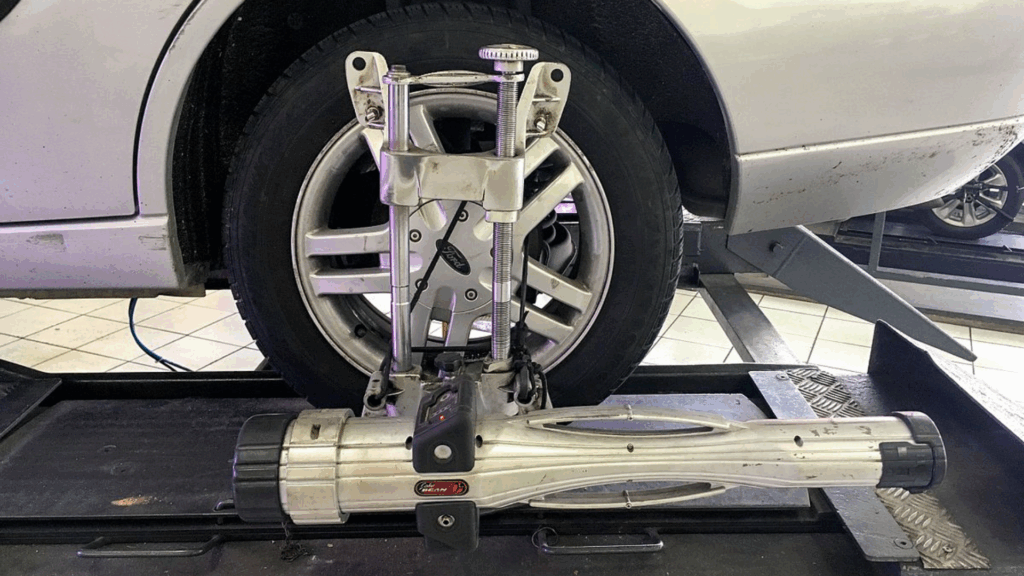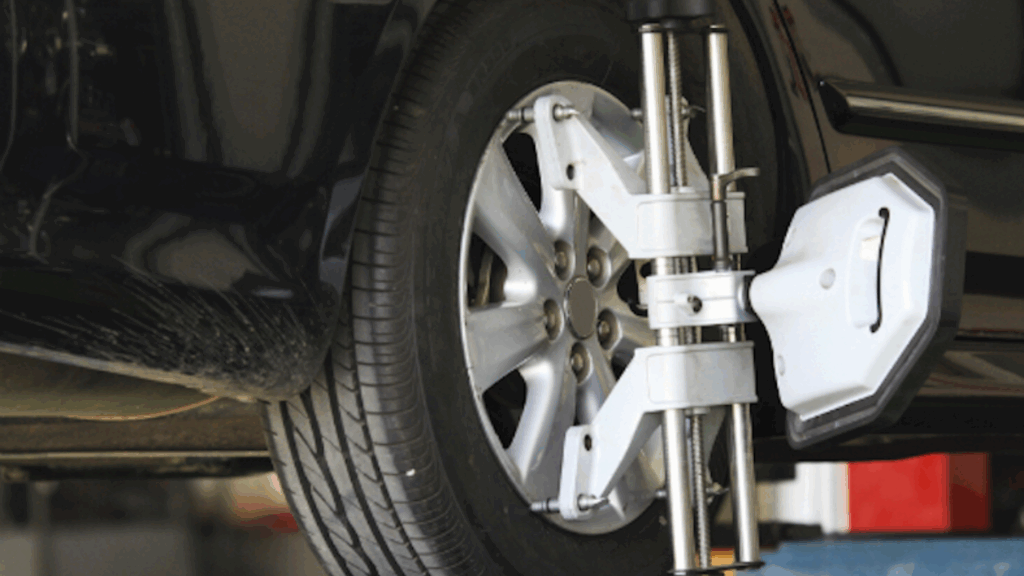When my car started to shake and drift slightly to one side, I knew something was off. It wasn’t just uncomfortable, it made me wonder if I was damaging my tires or suspension.
That’s when I learned the importance of knowing the difference between wheel alignment and tire balancing. These two services sound similar, but handle completely different issues.
One deals with how the tires sit and angle on your car, while the other focuses on weight distribution across each wheel. Both play a huge role in how smoothly and safely your vehicle drives.
In this blog, I’ll break down what each one involves, what signs to watch for, and how to decide which service your car might need.
What Is Wheel Alignment?

Wheel alignment is the process of adjusting the angles of your vehicle’s wheels so they are set to the manufacturer’s specifications.
These angles, camber, caster, and toe, determine how the tires make contact with the road. Camber refers to the inward or outward tilt of the wheels when looking at the car from the front.
Toe describes the angle at which the tires point in relation to each other when viewed from above, similar to being pigeon-toed or duck-footed.
Caster is the angle of the steering axis when viewed from the side, which affects steering stability and cornering.
The purpose of wheel alignment is to ensure that your vehicle drives in a straight line, handles predictably, and allows your tires to wear evenly.
What Causes Misalignment?
Several everyday driving situations can throw your wheels out of alignment. One of the most common causes is hitting potholes or curbs, which can jolt the suspension and shift wheel angles.
Even minor accidents or fender benders may be enough to cause misalignment, especially if they affect the wheels or frame.
Over time, suspension components like ball joints, bushings, or shocks can wear out and allow the wheels to shift from their correct positions.
Additionally, carrying excessive weight in your vehicle for long periods can strain the suspension and affect alignment angles. Even a small shift can have a noticeable impact on how your car drives.
Symptoms of Poor Wheel Alignment
Poor wheel alignment can lead to several noticeable issues that affect how your vehicle handles and how your tires wear.
If you’re experiencing any of the following signs, it may be time to have your alignment checked by a professional.
- Vehicle pulling to one side: You might feel the car drifting left or right even when you’re holding the wheel straight.
- Uneven or rapid tire wear: Misalignment causes tires to wear more on one edge, shortening their lifespan.
- Crooked steering wheel when driving straight: The steering wheel may not sit centered, even though you’re going straight.
- Squealing tires: Wheels out of line can create friction and noise as the tires drag across the pavement.
What Is Tire Balancing?

Tire balancing is the process of correcting uneven weight distribution in a wheel and tire assembly. Even when tires are brand new, they can have minor weight differences that lead to imbalance.
Balancing ensures that each wheel spins smoothly without causing vibrations, which helps improve ride quality, extend tire life, and reduce stress on suspension components.
The process involves placing the wheel and tire on a specialized balancing machine that spins the assembly to identify any areas of imbalance.
Once detected, a technician attaches small wheel weights at specific points to counterbalance the uneven areas.
There are two main types of tire balancing: static balancing, which corrects vertical movement (up and down), and dynamic balancing, which addresses lateral movement (side to side).
Symptoms of Tire Imbalance
When your tires are out of balance, the effects are often felt throughout the vehicle. These symptoms typically show up while driving at higher speeds and can make the ride uncomfortable and even unsafe.
Recognizing these signs early can help prevent further wear and tear on your tires and suspension system.
- Vibrations in the steering wheel, seat, or floor: A shaky sensation while driving, especially at high speeds.
- Scalloped or cupped tire wear: Uneven tread patterns that look wavy or bumpy across the tire surface.
- Noisy ride at highway speeds: Increased road noise caused by uneven tire contact with the pavement.
Wheel Alignment vs Balance: Key Differences
Although wheel alignment and tire balancing are often confused, they serve very different purposes. Understanding the key differences can help you identify the right service when handling tire-related issues.
| Feature | Wheel Alignment | Tire Balancing |
|---|---|---|
| What it adjusts | Suspension angles (toe, camber, caster) | Weight distribution of wheel/tire |
| Tools used | Alignment machine, lift, sensors | Balancing machine, wheel weights |
| Symptoms fixed | Pulling, uneven wear, and steering issues | Vibrations, noise, uneven tread wear |
| When to do it | After suspension work, uneven tire wear, pulling | After tire installation or vibration issues |
| Cost range | $75–$150 | $20–$80 per wheel |
| How often | Every 1–2 years or 12,000 miles | Every 5,000–6,000 miles or with new tires |
How Wheel Alignment and Tire Balancing Affect Vehicle Performance
Proper wheel alignment and tire balancing are essential for maintaining a smooth, efficient, and safe driving experience. Together, they improve fuel economy, handling, and tire longevity while protecting critical vehicle components.
Wheel Alignment
1. Improved Fuel Efficiency
When your wheels are misaligned, they create extra resistance by dragging slightly against the road. This forces your engine to work harder, which increases fuel consumption.
Proper alignment reduces this resistance and helps your car move more efficiently, ultimately saving you money at the pump over time.
2. Longer Tire Life
Misalignment causes uneven pressure on your tires, leading to one edge wearing out much faster than the other. This uneven tread wear means you’ll need to replace tires more often.
Keeping your wheels properly aligned ensures even contact with the road, allowing your tires to last longer and wear more uniformly.
3. Better Handling and Safety
Driving with poor alignment can make your steering feel loose, unpredictable, or crooked. This can affect how your car turns, brakes, and reacts in emergency situations.
Proper alignment keeps the steering wheel centered and your car stable, improving both everyday handling and your ability to stay in control when it matters most.
Tire Balancing
1. Smooth, Vibration-Free Ride
When your tires are out of balance, you may notice shaking in the steering wheel, seat, or floor, especially at higher speeds. This can make even short trips uncomfortable.
Balancing corrects the weight distribution across each wheel, reducing these vibrations and restoring a smooth, quiet ride for better driving comfort.
2. Protects Suspension and Steering Components
Constant vibration from imbalanced tires doesn’t just affect comfort; it puts added stress on your suspension and steering parts, like shocks, struts, and tie rods.
Over time, this can lead to costly repairs. By balancing your tires regularly, you help preserve these components and keep your vehicle running smoothly.
3. Prevents Uneven Tire Wear
An unbalanced tire tends to bounce or wobble as it rotates, leading to irregular tread patterns such as scalloping or cupping.
This uneven wear reduces tire life and can cause noisy, rough driving. Balancing ensures that each tire maintains steady contact with the road, helping it wear evenly and last longer.
When to Get a Wheel Alignment?
- After hitting a pothole, curb, or minor accident: These can easily knock your wheels out of alignment.
- After installing new suspension parts: Changes in suspension geometry can affect wheel angles.
- If your car pulls to one side: A drifting steering wheel is a common sign of misalignment.
- If you notice uneven tire wear: Misalignment often causes one side of the tire to wear faster.
- As part of regular maintenance: Check alignment every 12,000–15,000 miles, or once a year if you drive on rough roads.
- When buying new tires: Ensures your new tires wear evenly from the start.
When to Get Tire Balancing?
- When you buy new tires: Even new tires can have slight weight differences that need correcting.
- After each tire rotation: Changing a tire’s position can affect balance and ride quality.
- If you feel vibrations at higher speeds: Shaking in the steering wheel, seat, or floor is a clear sign of imbalance.
- If you hear unusual tire noises: Whining or thumping sounds may point to imbalance issues.
- After a tire repair: Patching or plugging a tire can alter its weight distribution.
- During seasonal tire changes: Balancing ensures a smooth ride with both winter and summer tires.
- Every 5,000–6,000 miles as preventive care: Regular balancing protects suspension parts and extends tire life.
Can You Get Both Services at the Same Time?
Yes, and it’s often recommended.
Most tire shops offer tire balancing and wheel alignment together during tire installation or rotation.
Doing both ensures maximum performance, safety, and longevity from your tires.
If you’re unsure what’s wrong, a technician can inspect your wheels and let you know if one or both services are needed.
Cost Comparison: Wheel Alignment vs Balance
Both services are key for safe driving, but alignment usually costs more because it involves adjusting suspension angles. Balancing is quicker and often cheaper, especially with new tire purchases.
| Service | Type | Estimated Cost |
|---|---|---|
| Wheel Alignment | Standard alignment | $75–$100 |
| Four-wheel alignment | $100–$150 | |
| Luxury/sports vehicles | $150+ | |
| With worn suspension parts | May cost more | |
| Tire Balancing | Per wheel | $15–$40 |
| All four wheels | $60–$80 | |
| Road force balancing | $100+ | |
| With a new tire purchase | Often included free |
Signs You May Need Both Alignment and Balancing
Sometimes the symptoms of wheel alignment and tire imbalance overlap, and your vehicle may require both services at once.
- Your car pulls and vibrates: A dual warning sign, pulling usually indicates alignment issues, while vibration suggests an imbalance.
- Tires wear unevenly and make noise: You may see scalloped or feathered tread wear along with increased road noise, especially at higher speeds.
- You recently had tire or suspension work done: Installing new tires, shocks, struts, or control arms can affect alignment and balance settings.
- Steering feels loose or off-center: If your steering wheel feels off, even after minor turns, or doesn’t return to center, both services may be needed.
- You notice decreased fuel efficiency and handling: Misalignment and imbalance can both cause drag, making your engine work harder and affecting how your car responds on the road.
- Unexplained tire wear shortly after service: If new tires wear out quicker than expected, improper alignment or lack of balancing could be to blame.
- You drive in rough or uneven conditions regularly: Frequent exposure to potholes, gravel roads, or speed bumps can throw off both balance and alignment over time.
Conclusion
After dealing with both pulling and vibration in my own vehicle, I’ve come to appreciate the importance of knowing when to get a wheel alignment, a tire balance, or both.
If the steering wheel feels crooked or the car drifts to one side, it’s usually an alignment issue. If the ride feels shaky, especially at highway speeds, imbalanced tires are often to blame.
But more often than not, these issues show up together. Getting both services done at the same time helps prevent uneven wear, protects the suspension, and gives me a smoother, safer driving experience.
When I see odd tire wear or feel something off while driving, I don’t wait; I book an inspection.
If you’re noticing signs too, don’t put it off. Schedule a tire service today and get back to a smooth, worry-free ride.

